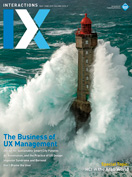Authors:
Gilbert Cockton, Simone Barbosa
Human-focused design (HFD) needs empathy, but who needs it most? Just the users, or do researchers and designers merit some too? Following her Ps & Qs column on impostor syndrome a year ago, Elizabeth Churchill shares advice on looking after ourselves. In the Business of UX forum, Dirk Knemeyer and Jonathan Follett discuss planning for the future as much of our current work becomes automated. When it comes to maintaining a UX beacon in all storms, Dan Rosenberg's cover story counsels the UX managers among us: We are not all one us, nor are we all some particular one of us. Albrecht Schmidt reminds us in his Interaction Technologies forum that when passwords are still deployed ineffectively for security, none of them, the users, are to blame. It must be one of us, but who? Us and them mean different things at different times and in different places.
One of the clearest trends in HCI has been the continuous extensive expansion of who gets to be them. Greg Nudelman, in his Abracadabra, both sharpens and blurs the boundaries between us and them. It's not our job to speak for them. It's our job to work in partnership, but with whom? This issue samples our current partners from diverse populations. Many of us could be the users of self-care technologies in Francisco Nunes's Health Matters article, but here, who has to be us as complete individuals, not just some clinical slice that interests medics. Most of us in high-resource countries could be one of them in Jonathan Bean's Consuming Tech column, with his secretive digital-heating system. In contrast, there are low-resource communities in high-resource countries: In Day in the Lab, Andrea Parker's Wellness Technology Lab focuses on vulnerable and marginalized populations. In Demo Hour, the vital self-care of hydration is made self-service for people with dementia in Lewis Hornby's Jelly Drops, and Joran van der Sluis, Wessel Fletterman, and Mark Zwart's App een Oma connects the elderly in physical ways to digital communication.
In this issue's special topic on Arab HCI, Galal Galal-Edeen, Yasmeen Abdrabou, Maha Elgarf, and Hala Hassan report that HFD practices that are straightforward in high-resource countries are less straightforward elsewhere. In the introduction, Shaimaa Lazem, Ebtisam Alabdulqader, and Mohamed Khamis draw attention to how us and them can differ in Arab communities. Soud Nassir, Adel Al-Dawood, Elham Alghamdi, and Eman Alyami share their research experiences in Saudi Arabia, while Max Krüger, Ana Duarte, Anne Weibert, Konstantin Aal, Reem Talhouk, and Oussama Metatla apply a postcolonial lens to projects with a remote community and with refugees.
Who need not be a potential stakeholder, but someone like them in some way. In What Are You Reading, Wendy Moncur shares her reading of myth and autobiographies as a source of insights for her research on identity, relationships, and transition in our digital age. Elsewhere, some target partners find themselves in myths of our own making, as Nithya Sambasivan argues in her Next Billion forum: Projects should not proceed when technology needs are myths. Furthermore, as Marion Koelle, Thomas Olsson, Robb Mitchell, Julie Williamson, and Susanne Boll discuss in their CHI 2018 workshop report, technologies have to be socially acceptable as well as necessary. We also encounter niche partners in Blog@IX, where Catherine Bischofberger reports on HMIs for smart-grid electricity transmission. Electric power runs through this current issue from Demo Hour, where Jordan Hamilton and Liam Stephenson's Emitts make electrical work safe and simple, and Dennis Siegel's Electromagnetic Harvester collects power from electromagnetic fields.
HCI no longer partners only with people. Rachel Clarke, Sara Heitlinger, Ann Light, Laura Forlano, Marcus Foth, and Carl DiSalvo report on a PDC 2018 workshop on smarter cities that are more than human. This could include the WiFi cat in EXIT or the Social Robotic Donuts in Harvey Bewley and Laurens Boer's How Was It Made.
Whoever us and them are in HCI, we need smart hows in our partnerships. As ever, Interactions gives us new glimpses of possible hows as apps, cats, gadgets, jelly drops, mitts, robots, and urban ecosystems. Diversity is everywhere: us (who?), them (who?) and how (what?). This time next year, there will be even more. These trends show no signs of stopping.
Gilbert Cockton and Simone Barbosa [email protected]
Copyright held by authors
The Digital Library is published by the Association for Computing Machinery. Copyright © 2019 ACM, Inc.








Post Comment
No Comments Found